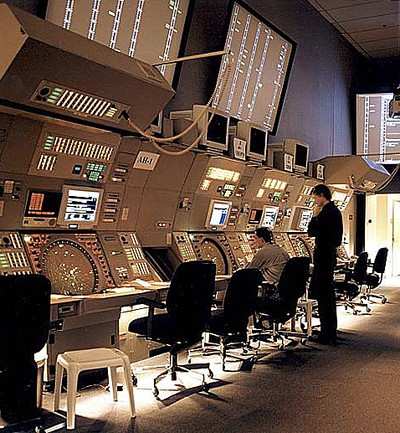Calls For DOT To Intervene
"We told you so!" So says the National Air Traffic
Controllers Association, which this week announced its worst
predictions about how veteran controllers would react to being
forced to work under an FAA-imposed contract have come to pass. The
union says controllers are retiring faster than the FAA
projected... and as a result, the remaining workers cannot handle
the flood of traffic during peak hours in Atlanta, Chicago, New
York and Southern California centers.

"We have come to a crossroads in these four locations," NATCA
president Patrick Forrey told The Associated Press. "We have so few
veteran controllers left that we cannot safely handle the volume of
aircraft into these major areas during the busiest periods of the
day. They are being asked to handle so much volume with so little
rest and with fewer eyes and ears that they are fatigued, and when
you are fatigued you make mistakes."
On Wednesday, NATCA declared a "staffing emergency" at those
centers, saying controllers do not have enough trained and
experienced personnel on the ground to safely handle the volume of
traffic in the air and at major airports. The union has called on
the Department of Transportation to intervene.
NATCA projects that by February 3 -- one-third of the way
through the 2008 fiscal year-- 500 controllers will have retired
already, with 2,200 more controllers able to retire by year’s
end. The union says 357 controllers have retired so far since
October 1, 2007 -- including 201 on January 3 alone. Another 130
have told NATCA they intend to retire by February 3 "due to the
lack of any incentive to stay on the job."
The union asserts the current trend, if it continues, will
shatter the FAA’s projection of 695 retirements this fiscal
year... and perhaps even the record of 856 retirements set in
fiscal year 2007.

There is no love lost between the FAA and NATCA. In September
2006, the FAA declared an impasse in contract talks with the union
-- following months of contentious bickering, and more than a few
walkouts on both sides -- and forced its own contract on
controllers. The union predicted many experienced controllers would
opt to retire early, rather than work under the new contract.
Regardless of political machinations, many veteran controllers
-- hired after President Reagan fired air traffic controllers
following the 1981 PATCO strike -- are eligible for retirement now.
The FAA has pursued a vigorous recruiting effort for new bodies,
pairing new hires with experienced controllers for on-the-job
training wherever possible.
FAA Chief Operating Officer acknowledged, "We do have a few
facilities where we're tight" on staffing -- but he emphasized
"nothing in our data shows any increase of errors where staffing or
fatigue have been contributory. We do not believe we are running an
unsafe system."
Agency spokeswoman Laura Brown said the FAA is aware of 301
retirements so far in FY2008... far fewer than the 500 cited by
NATCA. She did admit the agency has revised upward its earlier
estimate for retirements, but wouldn't say publicly what that
number was.
NATCA's Forrey said regardless, the agency has a definite
problem in keeping controllers on the job... which, in turn, puts
passenger aircraft in genuine danger.
"An already dangerous situation is about to get worse," said
Forrey. "An additional 2,200 experienced controllers will be able
to retire by the end of this year, thinning the already-depleted
ranks of the workforce at a time when the skies have never been
more congested. The GAO has already stated that the risk of a
catastrophic accident on our runways around the nation is high.
Without an adequate amount of rested, well-trained controllers in
towers and radar facilities, the risk of an aviation accident now
includes the airspace as well as the ground."

Below are the leading reasons cited by NATCA for why controllers
are declaring a staffing emergency in selected cities:
ATLANTA
- The Government Accountability Office released a study last
month that cited 30 runway incursions at Hartsfield-Jackson Airport
in the past four years, the fifth most of any U.S. airport. There
were 11 controller errors in 2007, including one involving a Delta
flight that blew out its tires in aborting a takeoff into incoming
traffic headed to an adjacent, parallel runway. Both controllers
involved in the incident had recently worked overtime shifts.
- The GAO said 52 percent of controllers at Hartsfield Tower
regularly work six-day weeks. Overtime usage to cover for staffing
shortages rose from $419,000 in fiscal year 2006 to $1.015 million
in fiscal year 2007.
- At the Atlanta Terminal Radar Approach Control, controllers
have been working mandatory overtime for nearly two years. Overtime
usage rose from $603,000 in fiscal year 2006 to $1.92 million in
fiscal year 2007.
- Staffing at Atlanta TRACON has fallen to 68 fully certified
controllers from 76 a year ago. The FAA’s own data indicates
that this facility has more flights per controller than any
facility in the United States.
- At Atlanta Center, the nation’s busiest facility, there
are 279 fully certified controllers on staff, down from over 400
five years ago. Approximately 70 are eligible to retire this year.
Overtime is mandatory and total dollar amounts have doubled FAA
projections this past year.
CHICAGO
-
 There were a record 56
close calls at Chicago Terminal Radar Approach Control in Elgin,
Ill., due to controller error in 2007. The previous high was 28 in
2006.
There were a record 56
close calls at Chicago Terminal Radar Approach Control in Elgin,
Ill., due to controller error in 2007. The previous high was 28 in
2006.
- At Chicago Center in Aurora, Ill., from October 2007 through
December 2007, serious close call incidents caused by controller
errors more than doubled the FAA’s mandated limit for the
entire fiscal year. Controller positions have been combined while
some of these errors have happened, due to short-staffing.
Additionally, the number of errors that occurred during training
have risen.
- The Department of Transportation Inspector General announced
this week it will formally investigate the controller working
conditions at Chicago O’Hare Tower, Chicago TRACON and
Chicago Center, which handles all flights in airspace from Iowa to
Indiana. This is in response to a request last month by Sen. Dick
Durbin, D-Ill. The IG is expected to look at key factors that could
contribute to controller fatigue. The National Transportation
Safety Board has cited fatigue as a potential contributing factor
to the recent errors.
- In a reply to a Congressional inquiry, the FAA stated it had
only 76 fully trained and certified controllers on staff at Chicago
TRACON, 21 below the FAA’s own staffing target of 97. At
least 20 more will be needed (117) when the O’Hare
Modernization Phase 1 is implemented this November.
- The GAO study last month showed that O'Hare had the
second-highest number of near-collisions on runways between 2001
and 2006.
- There are only 46 fully certified controllers at O'Hare Tower.
That is 25 short of what is needed, not to mention what will be
needed to staff a second tower as part of the O’Hare
Modernization Phase 1.
NEW YORK
- The number of fully trained and certified controllers at JFK
Tower has dropped 42 percent since 2001 while traffic has increased
40 percent. There are now just 22 fully certified controllers on
staff. Of those, eight must retire this year and another four will
reach retirement eligibility.
- Controller errors at the New York TRACON in Westbury, N.Y.,
rose 27 percent last year from fiscal year 2006.
- At New York Center in Ronkonkoma, N.Y., controller errors hit a
three-year high of 66, including 10 that occurred during on-the-job
training.
SOUTHERN CALIFORNIA
- The number of fully certified and experienced controllers at
Southern California TRACON (SCT), which handles all flights going
in and out of the major airports in the entire region, has dropped
40 percent since 2004 and now stands at 159.
- With staffing numbers at SCT well below that needed to provide
adequate rest and recuperation time for controllers between shifts,
almost 85 percent of them are now regularly working six-day weeks.
In 2007, many controllers logged well over 40 days of overtime. The
amount of overtime the FAA has paid controllers to cover for
staffing shortages has risen from $261,000 in 2004 to $2.8 million
in 2007.
- FAA management officials last week were forced to slow down
traffic heading into Orange County, Long Beach and Ontario, Calif.,
airports due to short staffing at SCT.
- At Los Angeles Center in Palmdale, Calif., the on board
staffing is 310. One out of every three is a trainee and many are
only getting less than an hour per week of on-the-job training as
they move through a 3-4-year process to become a fully certified
controller. This large amount of trainees and the resources
required to train them are taxing the system.
- L.A. Center has the highest rate of serious operational errors
(category A and B errors, as defined by FAA) in the country, per
million flights, among en route centers (9.11; second is Chicago
Center at 8.45).
- LAX has had a number of close calls over the last 18 months,
including one last August in which two aircraft carrying nearly 300
people came within 37 feet of each other. There are 33 controllers
in the tower today, compared to 46 in the years when fewer close
calls occurred. Controllers must work an average of 2.3 overtime
shifts a month to compensate for the short staffing. On Wednesday,
the Los Angeles City Council affirmed NATCA’s position,
voting 14-0 in a call for the FAA to fully staff the tower.
 Aero-TV: DeltaHawks Diesel Power Steps Into the Spotlight
Aero-TV: DeltaHawks Diesel Power Steps Into the Spotlight NTSB Prelim: Mooney Aircraft Corp. M20K
NTSB Prelim: Mooney Aircraft Corp. M20K ANN FAQ: Turn On Post Notifications
ANN FAQ: Turn On Post Notifications ANN's Daily Aero-Linx (12.20.25)
ANN's Daily Aero-Linx (12.20.25) Aero-News: Quote of the Day (12.20.25)
Aero-News: Quote of the Day (12.20.25)






